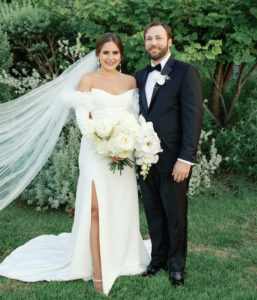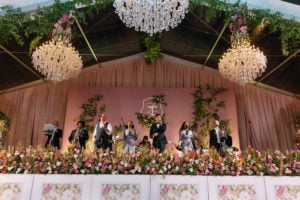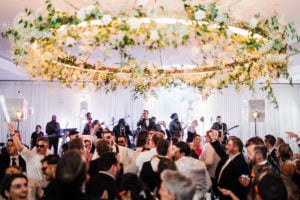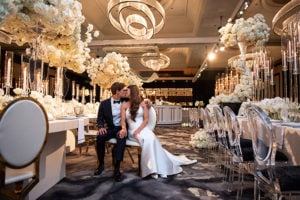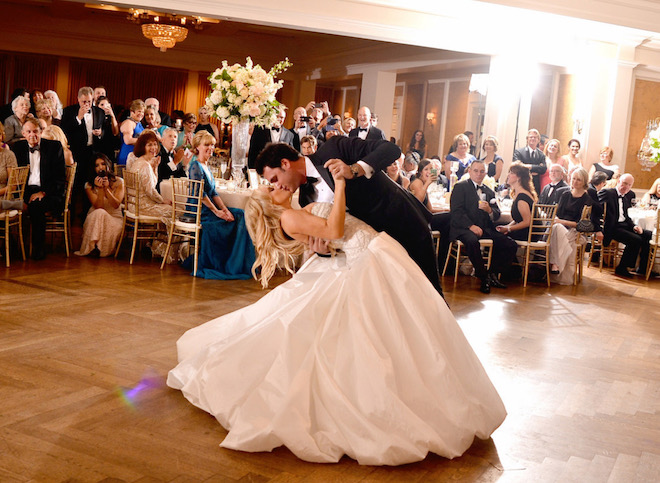
Be swept off your feet by this exclusive interview with Wedding Dance Houston. They dive deep into how their choreography makes it easy for couples to shine on the dance floor. Since 2003, Andrea Cody has honed her professional dancing experience into private lessons for choreographing wedding dances. When it comes down to deciding which style of dance and song selection to use, she accommodates every couple’s wants and needs. Join us as Andrea delves into the creative process of choreographing a dance that embodies a love story.
Keep twirling down the page for more insights from this Houston wedding choreographer and get ready to dance the night away!
Experience & Approach
Andrea Cody: Thank you for taking the time to learn about me! I love witnessing a couple’s love and devotion through dance. It is marvelous to see them take on a new challenge and accomplish their goals together. It’s an honor to be a part of their weddings and create precious memories for them.
Since beginning this specialization in 2003, I’ve choreographed over 1,000 unique first dances. I create 50 – 100 per year, including ballroom, Latin, swing, country, slow, contemporary, R&B, hip hop, Bollywood, lyrical, jazz, and freestyle. I start each dance by getting to know the couple. I want to know about their vision and goals as well as the logistics for their dance, including the venue, its layout, her dress, shoes and hairstyle, and their reception timeline. I also learned a lot about their style by reviewing any first dance videos that have inspired them.
Video inspirations are becoming more and more common, and I welcome the trend. It really helps a couple get on the same page with each other and with me to browse around and look at first dance videos. I post mine on IG and YouTube, by the way (hit that like button, lol.) I can work moves into a dance or create new moves that are similar yet better. I can usually think of a cooler, prettier, easier, and/or safer way to do other people’s moves. I also have a keen eye for how to modify a move to look best with a particular dress or hairstyle. I am experienced and up for restaging another choreographer’s entire dance for a first dance (after purchasing the choreographer’s instructional program and later giving him or her credit as the choreographer.) That being said, I am most confident in my own work, and I feel as though my creation process is more efficient, effective, tailored, and enjoyable than restaging another choreographer’s work. I prefer video inspirations to be just a jumping-off point for innovation.
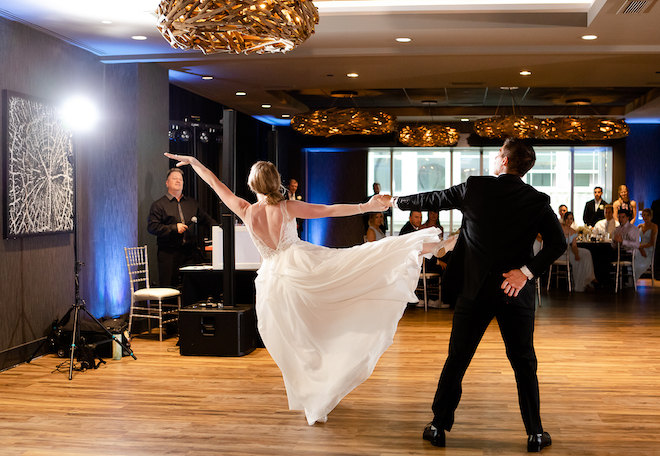
Song Selection
AC: Most couples already have a song picked out when they first reach out to me. If it’s a new song to me, I begin learning it and dancing to it to feel out the possibilities in terms of rhythms and movements. If they don’t have a song, I like for them to pick one. I want their dance to be an embodiment of their love. I feel like I would need their life story and hang out with them for a week on vacation to know them well enough to make the perfect suggestion. In the interest of time, I will suggest they consider their favorite recording artists and concerts they’ve been to, and I’ll send them my song list from past clients. The list is so exhaustive that they will either pick one from it or, having seen how really anything is possible, they will come up with a few possibilities of their own.
If they have a few song considerations, I’ll ask them to bring them all to our first lesson. I show them what kind of options they’d have for each song. We feel out which rhythms, tempos, and vibes are most natural for them as a couple. This process can be time well spent because it can save us from fighting with a song that doesn’t really suit us. The main thing I look out for is a couple that naturally moves pretty fast, efficiently, and with purpose in regular life and has a hard time dancing slow, soft, and laid-back. The inverse is also a problem.
They can take their time selecting a song. We can get started on connection and moves even without a song selected. Some couples have three songs in the running for the first 1-3 lessons, and as they try dancing to them, one of them becomes the clear winner. If there is a tie, I recommend a song with a strong beat that you can easily hear. Listen for the drums and bass. Songs with solo guitars or just strings like violins can be harder to follow.
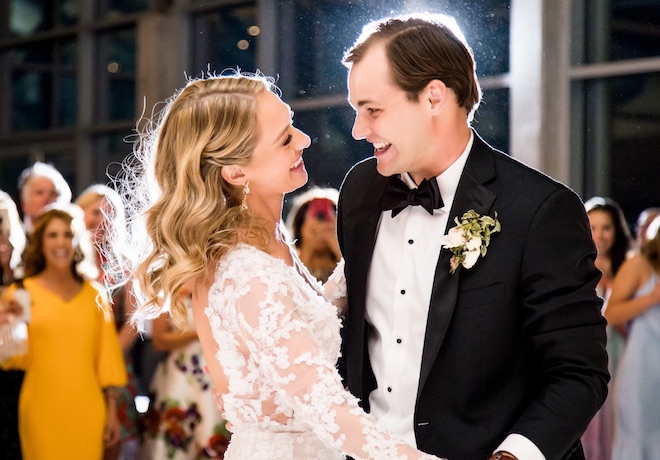
Tailored Choreography For Any Level
AC: When we first meet, my real understanding of their style begins developing. I demonstrate the different ways they could dance to their song (or song possibilities) together. This may include three or four variations on just the basic step they will do when they are not doing moves. I will also show how different moves from swing, ballroom, and Latin could go to their song and see which ones they like. I show them how we could structure the entire dance to be dynamic with slow, romantic parts as well as fun and exciting parts. I find out if they want to do dips and lifts. Once we have a game plan, I start in on the dance from the top.
I let the couple tell me how they feel about the dance as we create it. I’ll give them a few options for an introduction to getting on the floor. I start with a) simple, b) a little something, and c) a little more. If they pick the third option, then I’ll show them a fourth and a fifth. If they land on the fanciest and still want more, we’ll sprinkle in arm movements, footwork, and other gestures and expressions. But if they picked one or two, they clearly don’t need to consider anything more elaborate than that. At this time, I know a little more about their comfort level and how much of a show they want their dance to be.
After the introduction onto the floor, we usually begin with a little slow dancing, which may need a little rhythm work, whether or not it is a particular step. We will perfect our posture and begin developing our physical connection. Once the couple can take the floor and start slow dancing to the beat on their own, I will ask them to just tell me when they are ready for more. Some couples want to slow dance for 4-8 counts, others for the entire first minute. Seeing when they want to start doing moves gives me a better sense of how many moves they want to do overall and how to space them out to go with the song.
When we build the first movement sequence, which is typically before the first chorus or on the first chorus, I draw from the styles of partnering moves they like and give them a few more options that go with their song one line at a time. After a few lines, I know what the couple likes and their skill level, and I present moves for each additional phrase that they will want to do and can do. I may still give them two options, but I’m usually right the first time and don’t want to waste any time giving options they won’t select anyway.
I see how quickly they pick up the moves. If and when they try a move that is a little more difficult, I gauge their level of enjoyment at the challenge. Between our first and second lessons, I see how much they have retained and improved. From this point, I can estimate how many moves we can do and how intricate they can be while still finishing their dance and polishing it up in the amount of time they want to spend with me. If time is tight, I may suggest we repeat a section (perhaps facing a different direction for variety) or cut some of the music. If we have plenty of time, we will fine-tune the dance from the beginning every time we get together before moving on to learning new moves. We will also spend more time developing connection and rapport, and we will delve deeper into personal movement styling, timing, and musicality.
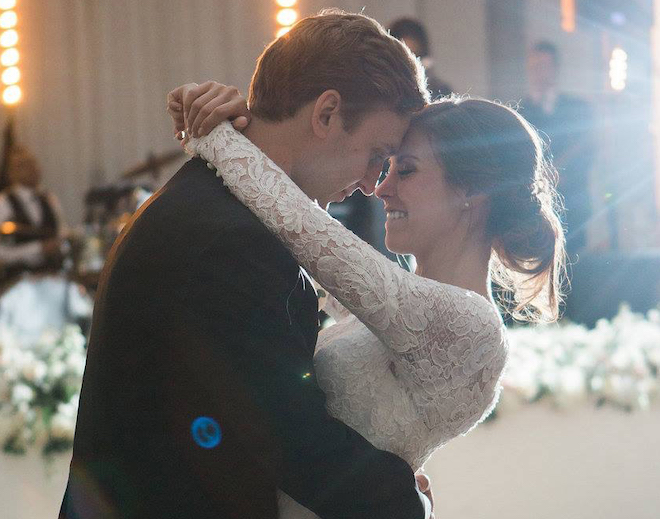
Practicing
AC: To assist their independent practice, couples are welcome to video their entire lesson, review moments during it, or, at the very least, a recap video at the end of each session. For a more intricate dance, I give the couple a spreadsheet with meticulous notes on their dance. I explain the physiology of how to develop muscle memory so they can use it to their advantage. I suggest they dance casually together, frequently, and to other songs in addition to their first dance song. Dance in the kitchen, around the house, and outside. Dance in a mirror. If they are learning a new step pattern like the two-step or waltz, they should dance the step down as often as they can around the house and even around their everyday lives, like an empty aisle at the grocery store, across the parking lot, or down the hall at the office. They’ll want to do the step as much as it takes to feel almost as easy as walking.
I encourage a groom who has taken on a lot of choreography to practice on his own by leading an imaginary partner, even while holding the notes or the video in one hand. I suggest he runs through the choreography in his head while doing other things like working out or waiting. I encourage brides to dance to their songs freely without thinking about choreography at all. Just dance to the song to feel the flow and develop your own style. Together or independently, video yourself from time to time to see how you are doing. A video is often surprisingly better than what you envision yourself doing.
Ideally, every couple will practice in the space and on the actual dance floor. Being in the exact space helps with spacing and mapping. The lead is mapping his dance in the place he is learning. In the practice space, his brain is thinking, “Turn toward the door and go toward the fireplace,” or, “Face the mirror, then go by the speaker.” Whatever it is, it’s a map filled with points in the practice room. All that goes away when changing spaces. While practicing, we talk about the venue so he can make a mental map of the venue overlaid in the practice space. That may be all he needs, but it’s still highly recommended to practice in the space. To practice properly in the space, the reception venue needs to be clear of any obstacles in the area where the dance floor will be. We don’t need to have the dance floor in place, but the space cannot be covered with tables and chairs (like for a luncheon or some other function.)
Feeling out on the dance floor is also a must. If you can’t get on it before the wedding day together, and you don’t want to see each other before your ceremony on your wedding day, then go individually with your shoes and just dance around on it. Ridiculous, right? Well, what’s worse is getting out there and slipping around, getting stuck, or stumbling over grooves. You can feel out a floor in a minute. If it is a problem, it’s no big deal, no matter what it is. You get used to it, and it doesn’t affect the dance. But if a couple is feeling out the floor during the first minute of their dance and there’s a problem, it’s not going to look or feel as good as it could. We want the first dance to get off to a good start!
The final practice should be a dress rehearsal. I encourage couples to run through their dance between the ceremony and reception after the dress has been bustled. Even if they don’t go all out, they can see what the moves are like in the dress, especially lifts and dips. While simply playing the song on your phone, this moment is a good time to reconnect, find your rhythm, and relax in each other’s arms.
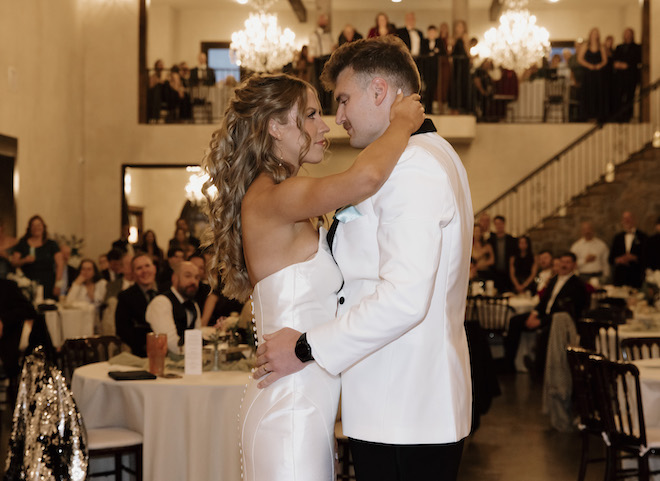
Making a Plan
AC: My packages range from 1 to 20 lessons, and most couples take 5 to 10 lessons. I suggest they pick a package that fits their goals and schedule. It is important for me to know roughly how many lessons I have with a couple so that I can tailor the choreography and instruction accordingly. I will make sure we complete the dance in the given time. Ideally, we will have another hour or two to polish it and a final hour together at the venue.
I am delighted to see couples planning their dances more and more in advance as the years go by. The creative process is so fun when we have time to try different moves out, play around and laugh together. I love it when the first dance becomes a long-term, romantic project. I believe dance is a blessing and the sooner you have it, the longer you can enjoy it together. I encourage couples to start on their first dance as soon as they can!
“Perfect Your First Dance with a Top Houston Wedding Choreographer” Spotlight WiH Partner- Choreographer: Wedding Dance Houston
Contributing Vendors- Al Torres Photography / Christina Montemuno Photography & Video / Cory Ryan / Kelly Hornberger Photography / Bailey Orr Photography

